KAD Industrial Services Inc. (KAD) has been providing products and solutions for all types of pump applications globally for over 20-years. We offer OEM and non-OEM pumps and pump parts for many different pumps such as: Gould, SRL, Warman, Galigher, Denver, Sala, Durco and many more.
KAD maintains production facilities across Asia and North America to serve our Global market. All assembly, testing and final quality assurance takes place in many of our affiliated facilities in North America.
KAD and our affiliate suppliers maintain ISO-9000 manufacturing facilities to ensure that all pumps are of the highest quality. We currently have 60,000 ft2 in warehouses in North America with full-service shop facilities and approximately 2 million dollars in inventory.
Our clients choose KAD for our outstanding customer experience, service, cost savings and prompt delivery.
Our team of professionals and resources have been serving the industry market since 1979.
We are committed to treating our customers with personal care and consideration of their individual needs. KAD will meet the requirements of any project with cost efficiency and high-quality products and services. As our customer, you will receive our dependability and reliability, unsurpassed by any other supplier of our type in the world.
Dynamic Pumps
Dynamic pumps are classified into many different types. Some of them are discussed within the following, such as Centrifugal, Vertical centrifugal, Horizontal centrifugal, and submersible systems.
These types of pumps are the most commonly used worldwide. A centrifugal pump is a mechanical device designed to move a fluid by means of the transfer of rotational energy from one or more driven rotors, called impellers. Fluid enters the rapidly rotating impeller along its axis and is cast out by centrifugal force along its circumference through the impeller’s vane tips. The action of the impeller increases the fluid’s velocity and pressure and also directs it towards the pump outlet. The pump casing is specially designed to constrict the fluid from the pump inlet, direct it into the impeller and then slow and control the fluid before discharge.
 |
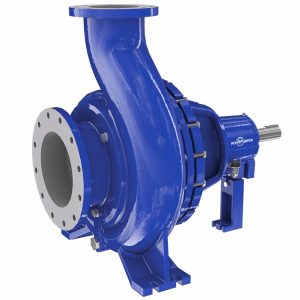 |
Vertical centrifugal pumps are a specific type of centrifugal pump that are specially designed to move water from an underground well or fluid reservoir. Some types of vertical centrifugal pumps include deep well turbine pumps, vertical turbine pumps, vertical cantilever pumps or line shaft turbine pumps. These are not to be mistaken for submersible pumps, as submersibles have an electric motor located underwater at the bottom of the pump. However, the electric motor of a vertical turbine pump is located above ground, connected via a long vertical shaft to impellers at the bottom of the pump. Despite the name, these pump types have nothing to do with turbines. Instead, the vertical turbine pumps are typically driven by an A.C. electric induction motor or by a diesel engine through a right-angle drive. The pump end consists of at least one rotating impeller attached to a shaft that directs the well water into a diffuser casing. These types of centrifugal pumps designed in a way where the impeller is “cantilevered” from the motor and baseplate. In a vertical centrifugal pump, only the impellers, bushings, and casing are submerged in the sump liquid; they have no submerged seals, bearings, or suction check valves. The overhung shaft is supported by heavy-duty bearings (located above the pumped liquid).
 |
 |
This is a type of centrifugal pump where the shaft connected to the electric motor and impeller lays in the horizontal plane. In a horizontal centrifugal pump, fluid enters into the pump casing and falls on the impeller blades, which are whirled tangentially and radially outwards. While passing through the impeller, the fluid gains both velocity and pressure for further transmission of fluid from a low point to a high point. The fluid then leaves the impeller and proceeds to the diffuser part of the casing for fluid conveyance. Horizontal centrifugal pumps can be provided as “multistage pumps”. In a multistage pump, there is more than one impeller that helps to gain more velocity and pressure.
The multistage horizontal centrifugal pumps are easier to install and maintain. The horizontal position of this type of pump provides easy access to the internal parts. According to the position of the Suction and discharge nozzle, the pump can be of the following type: Top Suction Top discharge, Side Suction Top Discharge, Side Suction side discharge.
 |
 |
All of the impellers are in a similar shelter and mounted on a similar shaft. Every impeller enhances the available pump head by an equal amount. Multi-stage pumps can also be single, or double suction on the first impeller.
A slurry pump is a centrifugal pump, specifically designed for hydraulic conveyancing of abrasive and often corrosive solid particles within a carrier fluid. The slurry pump operates the same way as a typical centrifugal pump, but should be of a low specific speed design, allowing slower operating speeds than conventional pumps in order to reduce the velocity of the solid particles and thereby reducing wear rates. Slurry pump components that come in contact with the pumped fluid are manufactured from wear resistant metallic or elastomeric materials, selected to suit each particular application.
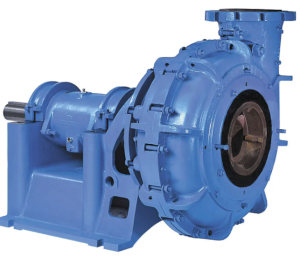 |
 |
A horizontal split case pump is a unique type of centrifugal pump whose casing is divided into two distinct chambers, which is different from inline or end suction pumps that are assembled with the suction nozzle, discharge nozzle, and casing in one chamber.
 |
 |
The casing can be split vertically or horizontally, relative to the impeller, which gives you either a vertical split case or a horizontal split case pump, respectively. We can also offer custom configurations to optimize the pump for specific applications.
Horizontal split case centrifugal pumps are designed with the suction and discharge nozzles in the bottom half of the casing, side by side, while the impeller shaft is positioned between two bearings, one on each side.
This rugged but simple design is particularly suitable for higher flow applications as it reduces thrust loads and allows for operation over a broad range of capacities. With proper application, HSC pumps offer minimal power consumption, low maintenance costs, and extended service life.
These pumps are also named as stormwater, sewage, and septic pumps. The applications of these pumps mainly include building services, domestic, industrial, commercial, rural, municipal, & rainwater recycle applications.
 |
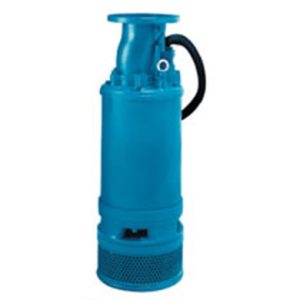 |
A submersible pump is a device which has a hermetically sealed motor close-coupled to the pump body. The whole assembly is submerged in the fluid to be pumped. The main advantage of this type of pump is that it prevents pump cavitation, a problem associated with a high elevation difference between the pump and the fluid surface. Submersible pumps push fluid to the surface, rather than jet pumps, which create a vacuum and rely upon atmospheric pressure. Submersibles use pressurized fluid from the surface to drive a hydraulic motor downhole, rather than an electric motor, and are used in heavy oil applications with heated water as the motive fluid.
The centrifugal pumps from Pioneer Pump deliver unparalleled flow, head and efficiency. These pumps are capable of outstanding hydraulic performance for both solids handling and clear liquids. They are built to ensure longevity and reliability in even the harshest conditions, while maintaining efficiency with their “green” design.
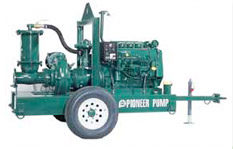
We carry the RedaHPS horizontal multistage pump, which is a cost-effective, low maintenance alternative to conventional high-pressure pumps. The system is proven reliable and customizable for your specific needs, serving a variety of applications, including reservoir pressure maintenance, mine dewatering, pipeline boosting, and much more. The system delivers power you can count on for your surface pumping applications.

Positive Displacement Pumps
A positive displacement pump moves a fluid by continuously enclosing a fixed volume of liquid, with the aid of seal or valves, and transporting it through the conveyance system. Positive displacement pumps are classified into different types but some of them are discussed below like diaphragm, gear, and worm pumps.
A diaphragm pump (also known as a Membrane pump) is a positive displacement pump that uses a combination of the reciprocating action of a rubber, thermoplastic or Teflon diaphragm and suitable valves on either side of the diaphragm (i.e. check valves, butterfly valves, flap valves, or any other form of shut-off valves) to pump a fluid.
There are three main types of diaphragm pumps:
1. Those in which the diaphragm is sealed with one side in the fluid to be pumped, and the other in air or hydraulic fluid. The diaphragm is flexed, causing the volume of the pump chamber to increase and decrease. A pair of non-return check valves prevent reverse flow of the fluid.
2. Those employing volumetric positive displacement where the prime mover of the diaphragm is electro-mechanical, working through a crank or geared motor drive, or purely mechanical, such as with a lever or handle. This method flexes the diaphragm through simple mechanical action, and one side of the diaphragm is open to air.
3. Those employing one or more unsealed diaphragms with the fluid to be pumped on both sides. The diaphragm(s) again are flexed, causing the volume to change.
When the volume of a chamber of either type of pump is increased (the diaphragm moving up), the pressure decreases, and fluid is drawn into the chamber. When the chamber pressure later increases from decreased volume (the diaphragm moving down), the fluid previously drawn in is forced out. Finally, the diaphragm moving up once again draws fluid into the chamber, completing the cycle. This action is similar to that of the cylinder in an internal combustion engine. Diaphragm Pumps deliver a hermetic seal between the drive mechanism and the compression chamber, allowing the pump to transfer, compress, and evacuate the medium without a lubricant.
An elastomeric diaphragm can be used as a versatile dynamic seal that removes many of the limitations found with other sealing methods. They do not leak, offer little friction, and can be constructed for low pressure sensitivity. With the right material consideration, diaphragms can seal over a wide range of pressures and temperatures without needing lubrication or maintenance.
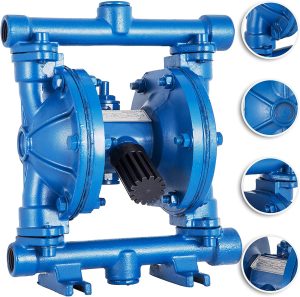
A gear pump is a type of positive displacement pump. It transports fluid by repeatedly enclosing a fixed volume of liquid using interlocking cogs or gears, transferring it mechanically using a cyclic pumping action. The rotating element develops a liquid seal with the pump casing and creates suction at the pump inlet. Fluid, drawn into the pump, is enclosed within the cavities of its rotating gears and transferred to the discharge. It delivers a smooth pulse-free flow proportional to the rotational speed of its gears. There are two basic designs of gear pump: external and internal.
An external gear pump consists of two identical, interlocking gears supported by separate shafts. Generally, one gear is driven by a motor and this drives the other gear (the idler). In some cases, both shafts may be driven by motors. The shafts are supported by bearings on each side of the casing.
1. As the gears come out of mesh on the inlet side of the pump, they create an expanded volume. Liquid flows into the cavities and is trapped by the gear teeth as the gears continue to rotate against the pump casing.
2. The trapped fluid is moved from the inlet, to the discharge, around the casing.
3. As the teeth of the gears become interlocked on the discharge side of the pump, the volume is reduced and the fluid is forced out under pressure.
No fluid is transferred back through the centre, between the gears, because they are interlocked. Close tolerances between the gears and the casing allow the pump to develop suction at the inlet and prevent fluid from leaking back from the discharge side (although leakage is more likely with low viscosity liquids).
External gear pump designs can utilise spur, helical or herringbone gears.
An internal gear pump operates on the same principle but the two interlocking gears are of different sizes with one rotating inside the other. The larger gear (the rotor) is an internal gear i.e. it has the teeth projecting on the inside. Within this is a smaller external gear (the idler – only the rotor is driven) mounted off-centre. This is designed to interlock with the rotor such that the gear teeth engage at one point. A pinion and bushing attached to the pump casing holds the idler in position. A fixed crescent-shaped partition or spacer fills the void created by the off-centre mounting position of the idler and acts as a seal between the inlet and outlet ports.
1. As the gears come out of mesh on the inlet side of the pump, they create an expanded volume. Liquid flows into the cavities and is trapped by the gear teeth as the gears continue to rotate against the pump casing and partition.
2. The trapped fluid is moved from the inlet, to the discharge, around the casing.
3. As the teeth of the gears become interlocked on the discharge side of the pump, the volume is reduced and the fluid is forced out under pressure.
Internal gear pump designs only use spur gears.
 |
 |
A Worm Pump (more often referred to as ‘screw pump’) is a positive displacement pump that use one or several screws to move fluids or solids along the screw(s) axis. In its simplest form (the Archimedes’ screw pump), a single screw rotates in a cylindrical cavity, thereby moving the material along the screw’s spindle. This ancient construction is still used in many low-tech applications, such as irrigation systems and in agricultural machinery for transporting grain and other solids.
Development of the screw pump has led to a variety of multi-axis technologies where carefully crafted screws rotate in opposite directions or remains stationary within a cavity. The cavity can be profiled, thereby creating cavities where the pumped material is “trapped”.
 |
 |

